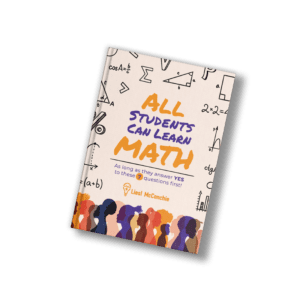ALL Students Can Learn Math
ALL students can learn math! But they aren’t.
Download this FREE 26-page e-book to discover the 7 essential questions ALL students must answer YES to first before deep mathematical learning can happen in school.

(Preview of pg. 1)
We hang posters in our classrooms, make t-shirts, and theme conferences around the mantra: ALL students can learn math. Is that really true, though? In theory, yes. It is true. The reality is, however, that many students are not learning math. In fact, only 40% of 4th graders are proficient in grade-level math. It gets worse. By 8th grade, only 33% are proficient at grade-level math (NAEP, 2018).
Why aren’t the posters, t-shirts, and mantras working?
Many teachers have been trying to solve the seemingly unsolvable math problem of why some students are performing so poorly in math. Some call it closing the math achievement gap, centering our math instruction, or reaching the students in the margins. Whatever you call it, the solution (like many great math problems) is found by asking the right questions.
Many great teachers and school leaders spend time reflecting and wondering how they can be better. For many, their questions have the word “I” in them, such as “How should I set up my classroom? What programs or curriculum will I use this year? What is the latest tech tool that I could use in my classroom?” (and on and on). But using the word “I” puts the focus on the teacher, rather than the learner.
To create mathematical environments where ALL students can learn math, focus on the questions students are asking. Your students ask far different questions than you would as they prepare for a day at school or even another year. These questions, and the resulting answers you provide, determine whether learning math is truly accessible to ALL students.
Read the rest of the e-book for FREE right now!
It is true that ALL students CAN learn math. Download this e-book to discover the tools needed to ensure ALL students ARE learning math.
The tools you have given me and my colleagues are invaluable! I can see the results immediately in my classes when I use the strategies that you share with us. You teach with passion, humor and an expertise within the field of teaching that I have never experienced before.
Nadia R., Teacher
